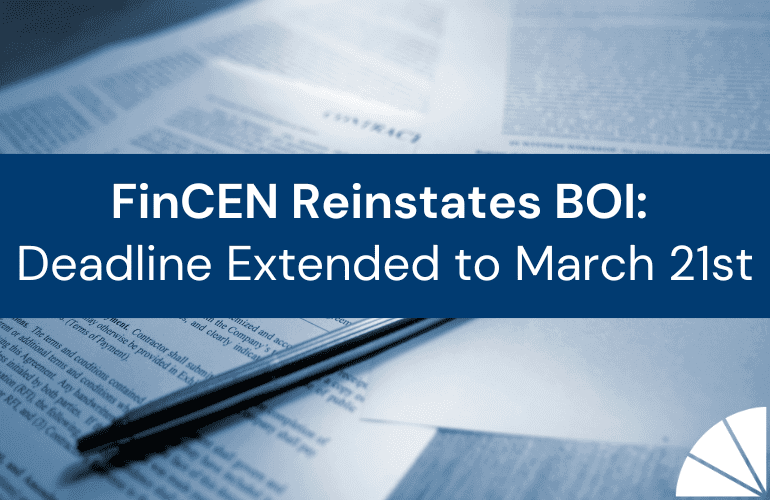
For businesses, rising interest rates, a challenging economy, and new tax law mean year-end tax planning is more essential now than ever. Whether this past year has been marked by success or survival, it’s time to engage in 2022 tax planning. As you prepare your business for the upcoming tax season, several strategies may help you reduce your tax liability.
Timing Income & Expenses
Suppose your business utilizes the cash-basis method of accounting, and you do not expect to see significantly higher profits in 2023. In that case, you may want to develop a year-end tax reduction strategy. For example, you could accelerate deductions into the current tax year by stocking up on supplies or paying 2023 bills or employee bonuses before the end of the year. To the same end, you could defer income into 2023 by pushing out invoicing to late December or early January. However, if you expect significantly higher profits next year, you should shift your strategy and accelerate income and push out deductions, as they may be more valuable in the future.
Maximizing Deductions
Qualifying business owners should maximize certain tax deductions while they are still available. For example, the 100% deduction for business meals provided by a restaurant is expiring at the end of 2022, which means the deduction will revert to 50% in 2023.
Business owners should also take the Qualified Business Income (QBI) deduction into account. The QBI deduction allows certain self-employed individuals and owners of pass-through entities to deduct up to 20% of income, gains, deductions, and losses (subject to certain limitations) resulting from a qualified trade or business. Per the TCJA, the QBI deduction is set to expire after 2025.
Leveraging Section 179 & Bonus Depreciation
Under Section 179, qualifying taxpayers can deduct 100% of the purchase price of new and used eligible assets, including machinery, office equipment, software, certain business vehicles, and some improvements to nonresidential property, as an expense at the time the property is placed in service. And by combining bonus depreciation, you could see substantial tax savings. In 2023, the allowable deduction will drop to 80% of the purchase price, and it will continue to drop by an additional 20% each subsequent year until it is eliminated in 2027.
For 2022, the maximum Section 179 deduction is $1.08 million and begins phasing out (on a dollar-for-dollar basis) once qualifying property purchases exceed $2.7 million. In addition, the maximum deduction is limited to the amount of your income from the business. However, unused amounts can be carried forward indefinitely or claimed as bonus depreciation without limitation or phaseout for 2022.
While Section 179 can provide immediate tax savings, the resulting reduction in adjusted taxable income could trigger the limitations on business interest expense deductions. You should also consider any charitable contributions, credit carryforwards, and expiring net operating losses affected by taxable income. Depending on your situation, having some depreciation available may prove more beneficial to offset your future income.
Preparing to Capitalize R&D Expenses
Unfortunately, the extension of research and development expensing and/or receiving a refundable research credit expired on December 31, 2021. So for the 2022 tax year, R&D expenditures can no longer be expensed in the first year of service. Businesses must amortize these expenses over five years for domestic research (15 years for foreign research).
There is the potential for legislation to intervene and include a continuation of fully expensing R&D expenses. An extension appears to have strong support on both sides of the aisle.
Taking Advantage of Energy-Efficiency Tax Credits
The Inflation Reduction Act amended, expanded and created new energy efficiency tax credits, which could provide significant savings, including the changes to the investment tax credit (ITC) and the production tax credit (PTC). These credits have been extended to qualified renewable energy projects beginning construction by December 31, 2024, and the credit amount has been increased for specific projects.
The ITC extension applies to solar energy generation, qualified fuel cell, waste energy recovery, and geothermal properties and standalone energy storage technology. The PTC extension applies to landfill gas, closed-loop and open-loop biomass, wind, trash, geothermal, and qualified hydropower facilities. With the exception of specific projects placed in service before January 1, 2022, the previously applicable credit phase-downs have been eliminated.
In addition, the Inflation Reduction Act extended the tax credit for energy-efficient new homes through December 31, 2032, and also created, expanded, and extended tax credits related to alternative fuels, advanced energy projects, biodiesel, renewable diesel, clean hydrogen production, and more.
Working with LGA
For LGA’s Business Tax & Advisory Services Teams, 2022 tax planning is a priority. My team provides our business clients with proactive solutions that help them ensure compliance and stay informed ahead of making key business decisions. I work with business owners at every stage of the business lifecycle to maximize tax-saving opportunities, minimize tax liabilities, and meet financial goals. Contact me today to discuss your 2022 tax planning strategy.






